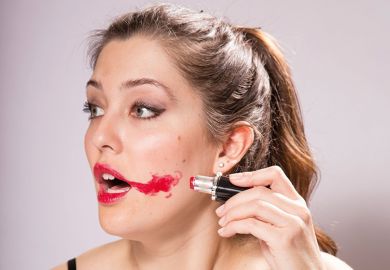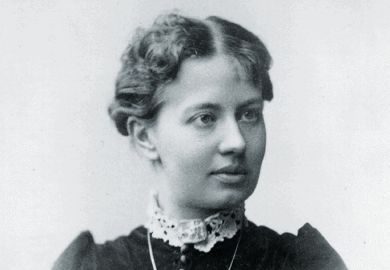For every leaf that drops off the tree outside my window, it seems like a “welcome, autumn!” meme lands in one of my social media feeds. And as the northern hemisphere nights draw in and the condensation starts to run, the urge to light some candles and cosy up with a good book or binge on a new television box set grows irresistible.
Everyone I know seems to be picking up the new Sally Rooney novel, Beautiful World, Where Are You, or ploughing through Netflix’s new academic drama, The Chair. And they may well be tempted to take up the accompanying new fashion trend, too: dark academia.
Like many other academics, I laughed when I saw the HuffPost report on the latest sartorial craze on TikTok. I’ve known plenty of goths with PhDs, but surely “dark academia” isn’t actually a trend? But a quick browse online showed me hundreds of moodboards pinned with tweeds and velvets, dozens of videos on how to put together a dark academic outfit, and, inevitably, a handful of posts detailing just why the dark academic trend is “problematic”.
Personally, after grinding through 18 months of pandemic, I would much rather dress in a blaze of autumn colour than drape myself in grey and black. Still, the allure is understandable when seen from the standpoint of its aficionados. Most of what’s out there about dark academia seems to be written by young adults who have taken Donna Tartt’s The Secret History as a how-to guide for university life rather than as a cautionary tale. They imagine academia as like the set of Sky One’s Oxford-based series A Discovery of Witches, full of shadowy alleyways and dusty libraries peopled by good-looking men and women in blazers and cashmere, with all-expenses-paid fellowships.
This underlying fiction is harmless enough, but there is indeed something genuinely “problematic” about this aspirational trend, and it is a problem common to most popular cultural representations of academia: embodiment. Or rather, which bodies are not shown on screen or on page.
Recently, I was discussing with some women academic friends the press coverage of Beautiful World, Where Are You, particularly the photo shoots for Rooney’s interviews with Vogue and The Guardian. Although not an academic by profession, in both sets of photos Rooney looks like the poster girl for dark academia – she wears a series of sweaters and dark tartans, backlit with moody autumn light.
Rooney’s body type perfectly fits the public idea of what a female intellectual should look like: slim, pale, serious. The Guardian draws readers’ attention to her “very slight” frame, Vogue to her “doleful eyes”. Although Rooney herself is clearly painfully uncomfortable with scrutiny of her person rather than her work, journalists keep repeating the same tired tropes contrasting her big brain with her tiny body, echoing descriptions of earlier intellectual women, whose slimness is represented as an almost natural corollary to their lean prose.
Susan Sontag had a fraught relationship with her own body, and famously declared she preferred to pretend it wasn’t there – but her 2004 obituary in The Guardian described her as “serious, gorgeous”, folding her intellectual presence into a comment on her physical appearance. Sandra Oh’s role in The Chair is a refreshing change from a relentlessly white representation of academia, but she too is conventionally slim and has more than one cosy sweater in her costuming. Moreover, on-screen and literary representations of intellectual womanhood are, in general, still woefully devoid of women of colour, disabled women, and any woman whose body dares to creep above a UK size 10.
As a plus-size woman, I find it disheartening that we still seem to associate the life of the mind with slightness of frame. Christina L. Fisanick, associate professor of English at California University of Pennsylvania, has argued that fat women academics are seen as lazy, greedy and lacking in intellectual authority. And Elena Andrea Escalera, associate professor of psychology at St Mary’s College of California, has noted that student evaluations penalise women for their fatness.
A friend told me she felt that if a female academic didn’t fit the stereotype of being a slim, attractive woman dressed in black, she should be “unremarkable, bland, almost featureless”. Other friends told me about performative abstinence from eating that they had seen at conferences: women would peck at a couple of sandwich triangles while their male colleagues cheerfully hoovered up the rest. Dark academia is just the latest iteration of a long-term cultural trend that makes women who don’t fit the physical mould feel that they should shrink back into the shadows.
I have always been comfortable taking up space society might not want to give me, but after a year and a half stuck at home I am even less willing to feel confined. So I am calling for an alternative to dark academia: bright academia. Let’s refuse to pretend that seriousness precludes playfulness, that intellectual weight precludes physical appetite, that clarity of thought is naturally paired with whiteness of skin.
My autumn aesthetic will be the round joyfulness of a ripe pumpkin, demanding its own space in the patch.
Rachel Moss is a senior lecturer in history at the University of Northampton.
Register to continue
Why register?
- Registration is free and only takes a moment
- Once registered, you can read 3 articles a month
- Sign up for our newsletter
Subscribe
Or subscribe for unlimited access to:
- Unlimited access to news, views, insights & reviews
- Digital editions
- Digital access to THE’s university and college rankings analysis
Already registered or a current subscriber?








